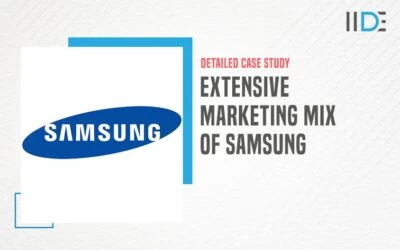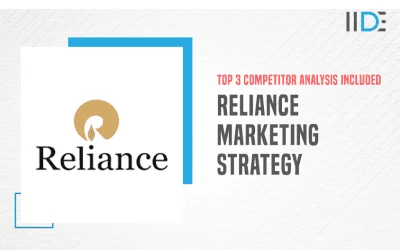Dove is one of the most recognizable cosmetics products in Unilever’s portfolio. It began as a simple beauty soap and has since expanded to include a whole line of personal and skincare products such as soaps, shampoos, conditioners, deodorants, moisturizers, etc. It was also ranked in the Forbes top 10 beauty brand.
In this blog, we will go through the marketing strategy of Dove including its 4 Ps. Let’s start by getting to know the firm better.
About Dove
Dove is a personal care brand that is a part of its parent company- Unilever. It was first introduced to the British consumer market in 1957. It is in the FMCG industry, and its primary selling point is that it has shown to be a single product with dual benefits, such as a moisturizer and a basic solution for dry skin. Their consumer base consists of men and women of any size, shape, or age. As its products are more expensive than those of its competitors, the brand has targeted consumers mostly in the upper and upper-middle classes.
Dove sells its products in around 150 countries and its logo is a silhouette profile of the brand’s namesake bird.
Current News about the brand
- Unilever India CEO says his successor faces rush to tap the giant market
- Maker of Dove Soap Will Drop the Word ‘Normal’ From Beauty Products
Buyer Persona

Buyer’s Persona
Name:
Bhavya Porkherl
Place:
Nepal
Age:
19 years
Profession:
Student
Motivation
- Eco-friendly products
- Handcrafted or natural products
- Huge variety of skin types
- Quality Products.
Interest & Hobbies
- Reading.
- Playing Villon
- Dancing
- Swimming
Pain Points
- Product Pricing
- Lazy for a skincare routine
- Limited product choices
- Stock Availability
Social Media Presence
- Tinder
- YouTube
- Quora
Marketing Strategy of Dove
The term marketing strategy refers to the foundation model of a firm, which has historically centered on product, pricing, place, and promotion (4Ps). The marketing strategy is defined as a collection of marketing strategies used by a firm to fulfill its branding objectives in the market. Dove’s marketing strategy has become increasingly inclusive and socially conscious over the years. The brand has expanded its focus beyond just body image to address issues like aging, skincare, and underrepresented communities.
As a result, it covers all aspects of a company’s marketing and commercial strategy. Let’s take a look at the Marketing strategy of Dove.
1. Product Strategy of Dove
Dove products are made using key components such as vegetable oils, synthetic surfactants, salts of animal fats, and moisturizing cream. The basic product line of the company is body washes, shampoo, soaps, and skincare products.

Some of its products include:
- Facial care products – Dove Deep Pure Face Wash
- Hair Care products- Dove Oxygen Moisture Conditioner
- Moisturizers/lotions – Dove Go Fresh Bathing lotion, Dove Purely Pampering Shea butter and warm Vanilla Body Lotion
- Dove Go Fresh Bathing Bar, Original Cream Beauty Bathing Bar
- Body Wash – Dove Go Fresh Body Wash
- Deodorant/antiperspirant – Dove Original Antiperspirant Deodorant Stick
The company is continuously expanding its product lines and is entering new markets to increase its customer reach and make available some products for every kind of customer.
2. Price Strategy of Dove

Dove is positioned as a luxury product in the market, yet the firm has a well-integrated pricing strategy for its products, which involves maintaining its price policy reasonable and cheap while being distinctive when compared to its competitor’s products.
Its products are slightly more expensive, but the brand has benefited greatly from the quality of its products, allowing it to effectively execute its pricing policy.
Consumers see Dove as a high-end product and are thus ready to spend additional money on high-quality items that will help them enrich their personal care experience. They have implemented a value-added pricing policy for all of their products since buyers typically associate high prices with high-quality items.
3. Place and Distribution Strategy of Dove

Dove is a multinational brand with a global reach. Its network is stretched around the world, and its products are manufactured in nations such as the United States, Thailand, Turkey, South Africa, the Philippines, Pakistan, the Netherlands, Mexico, Ireland, Germany, Israel, Indonesia, India, and China.
With the aid of a good and effective distribution chain, products are marketed in almost eighty countries. Manufacturers from retailers to customers are served via general stores retail stores, convenience stores, discount stores, supermarkets, malls, and hypermarkets.
4. Promotion Strategy of Dove


Dove has a high level of brand recognition in the consumer market, which has been achieved through branding and advertising. Marketing policies have a significant influence on the creation and development of the brand. Advertisements for many Dove products are shown on various television networks as well as on radio. It has also used print media to sell its products, placing advertisements in newspapers, magazines, and billboards.
They have implemented a unique promotional strategy with a purpose added in it, Rather than employing a superstar, they choose women to show the difference between before and after use of their products. In their advertisement, Dove typically shows clearer but natural skin in their ads rather than over-edited faces with visible make-up that gives out a false message. Ads use the phrase “real beauty” in the context of confidence, resulting in a strong client base of its own. It also has a strong social media presence on Twitter and Facebook.
So, that was the marketing mix of the company, let us also understand the competitive analysis for Dove to know the real position of the company.
Advertising and Marketing Campaign Strategies
Dove, a brand owned by Unilever, is known for its distinctive advertising and marketing campaign strategies that focus on promoting positive self-esteem, body confidence, and real beauty. Dove’s campaigns have received widespread attention and praise for challenging traditional beauty standards and promoting self-acceptance. Here are some key elements and examples of Dove’s advertising and marketing campaign strategies:
- Real Beauty Campaign: One of Dove’s most iconic campaigns is the “Real Beauty” campaign, which was launched in 2004. This campaign aimed to challenge narrow beauty ideals and celebrate the diverse beauty of real women. Dove conducted a global study that found only 4% of women considered themselves beautiful, and they used this insight to fuel their messaging. They featured women of different ages, sizes, and ethnicities in their advertisements, emphasizing that all women are beautiful.
- Self-Esteem Project: Dove’s Self-Esteem Project is a global initiative launched in 2004. It focuses on educating and building the self-esteem and body confidence of young people. Dove collaborates with educators, experts, and organizations to provide resources, workshops, and tools to improve self-esteem among young people.
- Campaign for Real Beauty: This ongoing campaign includes various elements, such as print ads, billboards, videos, and social media content, all promoting the message that beauty should be a source of confidence, not anxiety. One famous example is the “Evolution” video, which shows the transformation of a model through makeup and photo editing, highlighting the unrealistic beauty standards portrayed in media.
- #RealBeauty Sketches: In 2013, Dove released the “Real Beauty Sketches” video, which became a viral sensation. The video featured a forensic artist drawing women based on their self-descriptions and then based on descriptions by strangers. It revealed that women tended to describe themselves more critically than others did, reinforcing the importance of self-acceptance.
- Social Media Engagement: Dove actively engages with its audience on social media platforms, sharing empowering messages, inspirational stories, and user-generated content related to self-esteem and body confidence. They use hashtags like #RealBeauty and #SpeakBeautiful to encourage positive discussions.
How does this brand use Digital Marketing in its strategy?
Dove, the popular soap brand, has successfully utilized digital marketing in their strategy to connect with their target audience and promote their brand. One of Dove’s recent campaigns called “Real Beauty Sketches,” aimed to challenge the perception of beauty in society. The campaign featured a video where a forensic sketch artist drew portraits of women based on their own descriptions, as well as descriptions provided by strangers. The results showed that women were more critical of their own appearances, highlighting the need for self-acceptance and body positivity. This campaign went viral, generating over 163 million views on YouTube and sparking conversations about beauty standards.
Another example of Dove’s digital marketing strategy is its “Campaign for Real Beauty.” This long-running campaign aimed to promote self-esteem and challenge the unrealistic portrayals of beauty in advertising. Through various digital platforms, including social media, Dove encouraged women to share their stories, celebrate their unique beauty, and inspire others. This campaign received widespread recognition and engagement from women worldwide, reinforcing Dove’s commitment to promoting real beauty.
In addition, Dove has utilized digital marketing to connect with their audience through personalized content. One example is the “Beauty Bar,” which is an interactive feature on the Dove website. By entering their personal information, users receive tailored tips, advice, and product recommendations based on their specific needs and concerns. This personalized approach helps Dove build stronger relationships with their customers while providing them with relevant and valuable content.
Overall, Dove’s digital marketing strategy has been essential in spreading its message of self-acceptance, challenging beauty standards, and connecting with its target audience. These campaigns and initiatives have not only generated vast engagement and brand awareness but have also helped to reshape societal perceptions of beauty.
Competitive Analysis of Dove
As Dove is in the personal care industry, it faces tough competition from various other brands. The industry is moving at a very fast pace with the launching of new products frequently. Dove is trying to be a market leader by staying relevant to the trend and by doing extensive market research.
- Olay, owned by Procter & Gamble, offers skincare products, including anti-aging creams, cleansers, and moisturizers.
- Nivea is a global skincare brand known for its wide range of products, including lotions, creams, and body washes.
- L’Oreal is a multinational beauty and cosmetics company with a diverse portfolio of brands, including L’Oréal Paris, Garnier, and Maybelline, which compete in various segments of the personal care and beauty market.
- Lancome is a well-known luxury cosmetics and skincare brand that operates in the beauty industry.
- Neutrogena, also a subsidiary of Johnson & Johnson, is a well-known brand for skincare and beauty products, particularly for its acne and sun protection lines.
Suggestions for Better Campaigns
Campaign 1: “Dove Self-Care Sanctuary”
Concept: By developing a virtual environment where people can access tools, advice, and products to support their mental, emotional, and physical health, you can promote self-care and holistic well-being.
Benefits: Complies with society’s increasing emphasis on mental and emotional health. Establishes Dove as a company that is concerned about the overall health of its clients, and encourages people to prioritize their self-care practices by offering them useful resources and tools. Builds a sense of community as participants in online gatherings share their self-care experiences. Encourages the sale of self-care product bundles while enhancing brand loyalty.
Conclusion
Dove is a well-known personal care brand and is one of the world’s most popular skincare brands. Aside from its unique composition, which distinguishes it from other soaps and cosmetic products on the market, its marketing approach has also given it a distinct advantage. Its smart marketing techniques have helped it increase its market share and strengthen its client relationships. Dove’s product line has expanded with time without hammering the quality, and an increasing number of individuals have joined its effort to shatter false beauty standards.
Found the blog interesting? Read more such blogs on IIDE’s Knowledge Portal. If you want to learn more about digital marketing, Check out our Free Digital Marketing Masterclass by Karan Shah, CEO and Founder of IIDE.
Thank you for taking the time to read the blog. Do let us know your thoughts on the same in the comments below.








From not having celebrities advertisement to helding campaigns really marketing mix of dove has made the Dove a influential brand
Not hiring superstars to advertise their products is quite a unique marketing mix of Dove!